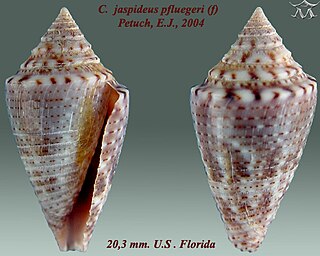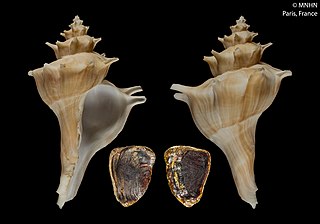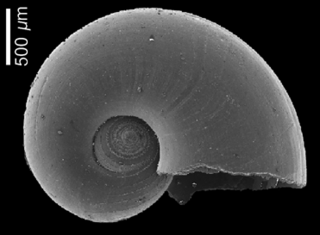Related Research Articles
The Neogene, informally Upper Tertiary or Late Tertiary, is a geologic period and system that spans 20.45 million years from the end of the Paleogene Period 23.03 million years ago (Mya) to the beginning of the present Quaternary Period 2.58 Mya. The Neogene is sub-divided into two epochs, the earlier Miocene and the later Pliocene. Some geologists assert that the Neogene cannot be clearly delineated from the modern geological period, the Quaternary. The term "Neogene" was coined in 1853 by the Austrian palaeontologist Moritz Hörnes (1815–1868).

Grebes are aquatic diving birds in the order Podicipediformes. Grebes are widely distributed freshwater birds, with some species also found in marine habitats during migration and winter. Some flightless species exist as well, most notably in stable lakes. The order contains a single family, the Podicipedidae, which includes 22 species in six extant genera. Although, superficially, they resemble other diving birds such as loons and coots, they are most closely related to flamingos, as supported by morphological, molecular and paleontological data. Many species are monogamous and are known for their courtship displays, with the pair performing synchronized dances across the water's surface. The birds build floating vegetative nests where they lay several eggs. About a third of the world's grebes are listed at various levels of conservation concerns—the biggest threats including habitat loss, the introduction of invasive predatory fish and human poaching. As such, three species have gone extinct.

Ecphora gardnerae is a species of extinct predatory ocenebrinid murex gastropod. Shells of E. gardnerae are found in Miocene-aged marine strata of Maryland and Virginia.
The Serravallian is, in the geologic timescale, an age or a stage in the middle Miocene Epoch/Series, which spans the time between 13.82 Ma and 11.63 Ma. The Serravallian follows the Langhian and is followed by the Tortonian.
The Langhian is, in the ICS geologic timescale, an age or stage in the middle Miocene Epoch/Series. It spans the time between 15.97 ± 0.05 Ma and 13.65 ± 0.05 Ma during the Middle Miocene.
The Middle Miocene is a sub-epoch of the Miocene Epoch made up of two stages: the Langhian and Serravallian stages. The Middle Miocene is preceded by the Early Miocene.

Hesperotestudo is an extinct genus of tortoise native to North and Central America from the Oligocene to the Late Pleistocene. Species of Hesperotesudo varied widely in size, with the largest unnamed species from El Salvador reaching 150 cm (4.9 ft) in carapace length, larger than that of extant giant tortoises. Historically considered a subgenus of Geochelone, it is now considered to be distantly related to that genus. Its closest relatives are the extant Gopherus and the extinct Stylemys. The ancestor of the three genera arrived in North America during the Early Eocene. The bodies of Hesperotesudo species were extensively covered with large dermal ossicles, which in life were covered in keratin. It has been suggested that species of Hesperotestudo were relatively tolerant of cold weather. Hesperotestudo became extinct at the end of the Pleistocene and beginning of the Holocene co-incident with the arrival of the first humans in North America, and sites have been found where Hesperotestudo were butchered.

The Choctaw Sea was a Cenozoic eutropical subsea, which along with the Okeechobean Sea, occupied the eastern Gulf of Mexico basin system bounding Florida.

Jaspidiconus is a subgenus of sea snails, marine gastropod mollusks in the genus Conasprella, family Conidae, the cone snails and their allies.

Forreria is a genus of marine gastropod mollusks in the family Muricidae, the murex snails or rock snails.

Protatlanta rotundata is an extinct species of sea snail, a holoplanktonic marine gastropod mollusk in the family Atlantidae.

Ecphora is the common name for a group of extinct predatory marine gastropod mollusks within the family Muricidae, the rocks snails or murexes. The common name is based on the first officially described genus, Ecphora. The entire lineage of these ocenebrinid murexes are descended from the Eocene murex, Tritonopsis. Ecphoras are indigenous to the North American Eastern Seaboard, being found in marine strata from the Late Eocene until their extinction during the Pliocene. Many ecphora species are important index fossils.

Conasprelloides is a subgenus of sea snails, marine gastropod mollusks in the family Conidae, the cone snails and their allies.

Dalliconus is a subgenus of sea snails, marine gastropod mollusks in the genus Conasprella, family Conidae, the cone snails and their allies.

Gradiconus is a synonym of a subgenus of sea snails, marine gastropod mollusks in the genus Conus, family Conidae, the cone snails and their allies. T

Kohniconus is a subgenus of sea snails, marine gastropod mollusks in the genus Conasprella, family Conilithidae, the cone snails and their allies.

Ecphora is a genus of extinct predatory ocenebrinid murexes indigenous to the North American Eastern Seaboard from Miocene until their extinction during the Pliocene. The common name for this genus and a group of related genera is "ecphora"(s).

Lophocetus is an extinct genus of dolphin belonging to the clade Delphinida that is known from late Miocene (Tortonian) marine deposits in California and Maryland. Although usually placed in Kentriodontidae, recent studies have found it only distantly related to Kentriodon.
Leucosyrinx rugata is an extinct species of sea snail, a marine gastropod mollusk in the family Pseudomelatomidae, the turrids and allies.
Miobaptus is a fossil genus of grebe that is known from several specimens collected from Czechia and Lake Baikal dating from the Early Miocene to Middle Miocene. Considered to be one of the most primitive genus of grebes, the anatomy of Miobaptus suggests it was less adapted for the aquatic mode of life than modern grebes, but had better flight maneuverablity.
References
- ↑ Oxford English Dictionary, "Ecphora" entry.